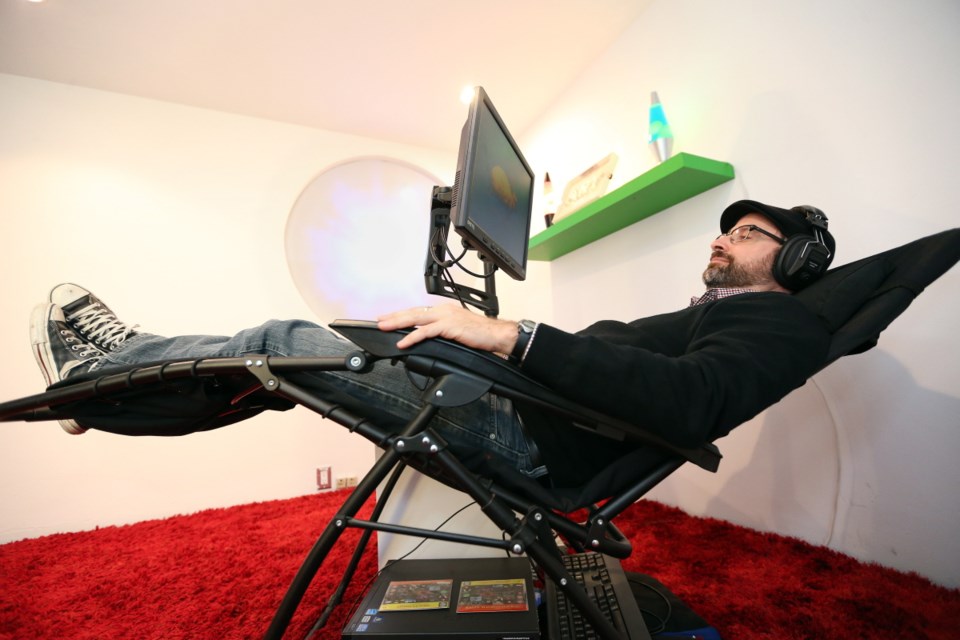What: Video Art Therapy #2: Videopsychotherapy
Where: Open Space gallery, 510 Fort St.
When: Opens Friday, continues to Dec. 13 (Artist’s talk Friday, 7 p.m., followed by a musical performance by Thomas Shields)
Admission: By donation
Need help for your many psychological and/or emotional problems?
Brian Macdonald has just what the doctor (or at least the artist) ordered.
The Victoria artist has created Video Art Therapy #2: Videopsychotherapy, an interactive installation opening Friday at Open Space gallery. For no charge (well, donations are suggested) visitors can experience a personalized, computer-generated therapy session simply by sitting at a desk and following simple commands projected on a video screen.
This week, I tried it out. First, Video Art Therapy #2: Videopsychotherapy asked me (in a sotto voce female voice) multiple-choice questions about the psychological problem I might be experiencing. Then, watching two actors interact with their voices garbled, I was asked to guess what they were talking about, typing out the answers. (It’s not easy — one scene has an actor posed upside-down wearing red long-johns, which is open to multiple interpretations.)
Finally, the diagnosis. I learned my quest for an active and enjoyable social life is hampered by my avoidance of social activities, due to anxiety. Video Art Therapy #2: Videopsychotherapy counselled me to focus less on myself, and more on the feelings of others.
Macdonald, 43, admits Video Art Therapy #2: Videopsychotherapy is tongue-in-cheek (visitors are cautioned not to view psychological advice dispensed as medical gospel).
It’s far from a joke, though. Part of the artist’s intent is to provide commentary on society’s technology-driven need for instant solutions. Macdonald figures these days, influenced by the speed of computer wizardry, we increasingly seek answers as quickly as the time it takes to search Google.
“I think,” Macdonald said, “we sort of have computer envy.”
He was interviewed at Open Space, midway through setting up his exhibition. The showcase also includes his 2007 work Art Therapy #1, in which an audience member sits in a dentist-style easy chair while viewing a video screen. Behind the chair is a Lite-Brite (a vintage light-box toy) spelling out the word “art.” The LiteBrite is flanked by a pair of glowing lava lights.
A media technician at Royal Roads University by day, Macdonald originally set out to be a filmmaker. The Brantford, Ont., native studied film and theatre at Western University, intending to pursue further film studies. However, Macdonald realized his interests were more esoteric than those of his filmmaking contemporaries — he wanted to push the boundaries further.
Giving up on becoming a movie-maker, he moved to Whistler to work in a wine and beer store. Then a friend employed at Whistler’s community cable TV station enlisted his help. Macdonald’s interest in video was kindled while shooting things like whitewater kayaking.
Previously, Macdonald had shot a short film, Sex and Sadness. In Whistler, he digitized the old VHS footage and reinvented it as an art film about two lovers. Dialogue (some of it in Polish) was reversed so the actors spoke backwards. Subtitles were added. The new 2001 version of Sex and Sadness became Macdonald’s first art-film success. So far, it’s played 25 film festivals.
Other art-video projects include Murder and UFOs, a silent film inspired by Marilyn Monroe’s death and the Kennedy assassinations, and Belated Eulogy for my Father.
The latter, a singular project, followed the death of Macdonald’s father in 2010. The funeral home had given Macdonald a DVD of the service. His siblings had spoken at his father’s funeral; however, at the time, Macdonald had felt unable to follow suit. Later, he took footage from the DVD and, using chroma-key compositing, inserted himself into the video to deliver a belated eulogy to his father.
Macdonald says his video art is typically concerned with themes of intimacy, isolation and psychology. One thing he hopes Video Art Therapy #2: Videopsychotherapy will do is encourage audience members to indulge in a few minutes of quiet contemplation (it ends by asking viewers to focus on a series of swirling images suggestive of plants and solar systems).
“[In Video Art Therapy #2: Videopsychotherapy] someone will tell you something that may or may not be about yourself,” Macdonald said.
“And you kind of reflect upon that. You go, ‘Is this right?’ ”
